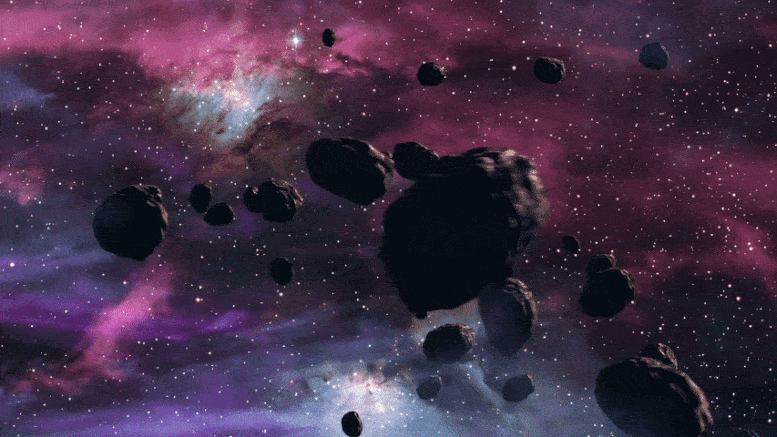

A study by scientists from the Institute of Geosciences and Exact Sciences of the São Paulo State University (IGCE-UNESP) in Río Claro, Brazil, identified 19 asteroids of interstellar origin classified as Centaurs, external objects of the Solar System that revolve around the Sun in the region between the orbits of Jupiter and Neptune.
An article on the study titled “An Interstellar Origin for High-Inclined Centaurs” is published in the Monthly notices from the Royal Astronomical Society. The study was supported by FAPESP.
“The Solar System was formed 4.5 billion years ago in a stellar nursery, with its systems of planets and asteroids. The stars were close enough to each other to foster strong gravitational interactions that led to a material exchange between the systems. Therefore, some objects now in the Solar System must have formed around other stars. Until recently, however, we were unable to distinguish between captured interstellar objects and objects that formed around the Sun. The first identification was made by us in 2018, “María Helena Moreira Morais, one of the two co-authors, told Agência FAPESP .

The discovery by a Brazilian researcher published in the Monthly Notices of the Royal Astronomical Society provides clues to understanding the star nursery from which the Sun emerged. Credit: NASA
Morais graduated in applied physics and mathematics from the University of Porto (Portugal) and earned a doctorate in dynamics from the Solar System at the University of London (United Kingdom). She is currently a professor at IGCE-UNESP. The other co-author is Fathi Namouni, a researcher at the French Riviera Observatory in Nice, France.
The first identification that Morais referred to was asteroid 514107 Ka’epaoka’awela, as reported by Agência FAPESP in 2018.
The name Ka’epaoka’awela is Hawaiian and can roughly be translated as “mischievous companion of Jupiter moving in the opposite direction”. It has occupied the path corresponding to Jupiter’s orbit for at least 4.5 billion years, but it rotates around the Sun in the opposite direction to that of the planets, that is, it is a retrograde coorbital asteroid of Jupiter.
“When we identified it as an object that came from outside the Solar System, we didn’t know if it was an isolated case or part of a vast population of immigrant asteroids,” said Morais. “In this latest study, we recognized 19 centaurs of interstellar origin.”

The researcher’s composition of an artistic image from NASA used to show what the primordial solar system would be like, with the addition of a Centaur in polar orbit in the outer region. Credit: Maria Helena Moreira Morais
Similar to Ka’epaoka’awela, the centaurs identified in the study have highly inclined orbits with respect to the orbital plane of the planets. “To investigate the origin of these objects, we built a computer simulation that works like a time machine, traversing their trajectories backward for 4.5 billion years. The simulation allowed us to discover where these objects were at the time, “said Morais.
The planets and asteroids that originated in the Solar System arose from a thin disk of gas and dust that once orbited the Sun. For this reason, they all moved in the plane of the disk 4.5 billion years ago. If the Centaurs originated in the Solar System, they should also have moved in the plane of the disk at that time. However, our simulation showed that 4.5 billion years ago, these objects rotated around the Sun in orbits perpendicular to the plane of the disk. Also, they did it in a region distant from the gravitational effects of the original album, ”said Morais.
These two findings showed that the Centaurs did not originally belong to the Solar System and must have been captured from nearby stars during the planet’s formation period.
Star nursery
The discovery in the Solar System of a population of asteroids of interstellar origin is an important step in understanding the differences and similarities between objects that formed in the Solar System and objects in the Solar System that were originally extrasolar. Future astronomical observations and possibly space missions will deepen this understanding. “Studies of this population will shed light on the stellar nursery from which the Sun emerged, the capture of interstellar objects in the primordial Solar System, and the importance of interstellar matter for the chemical enrichment of the Solar System,” Morais said.
Regarding chemical enrichment, it is worth remembering that the primordial Universe is primarily made up of hydrogen and helium. The lightest natural elements on the periodic table were created by nuclear fusion within stars and then spread through space. The region in which the Solar System is located was chemically enriched with these elements, which contributed to the composition of the human body.
Reference: “An interstellar origin for high-leaning centaurs” by F Namouni and MHM Morais, April 23, 2020, Monthly notices from the Royal Astronomical Society.
DOI: 10.1093 / mnras / staa712